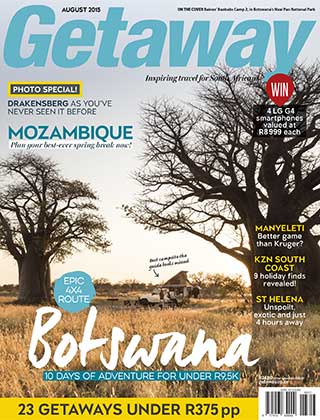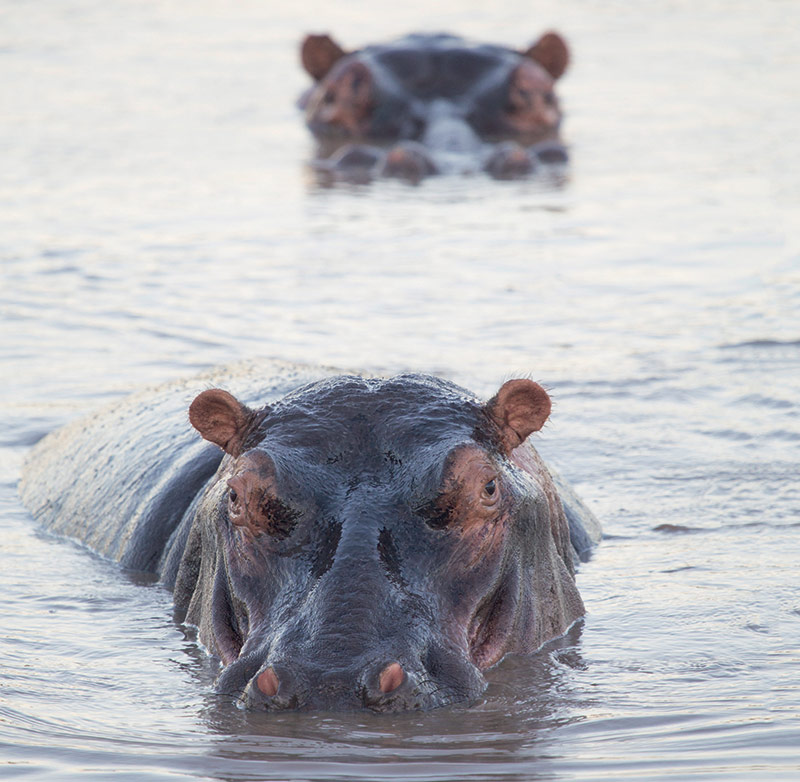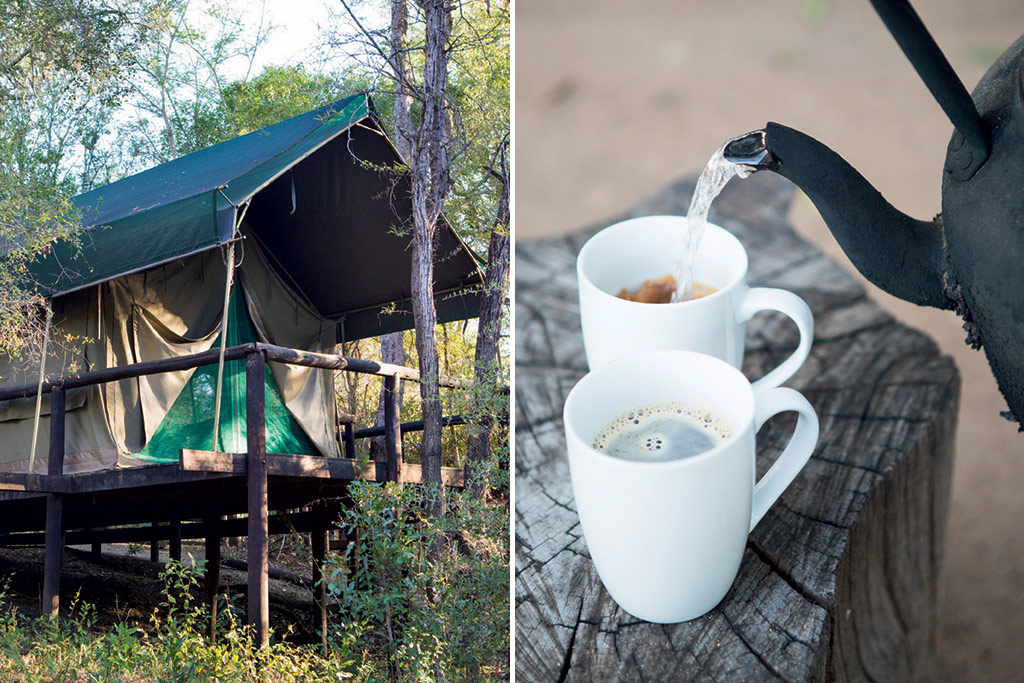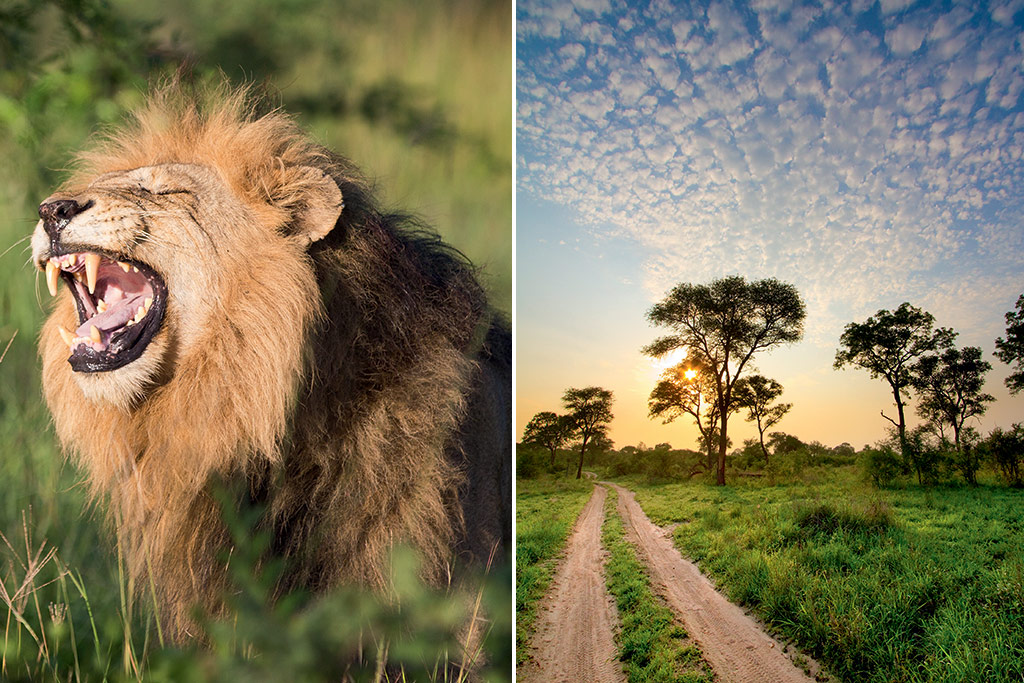How do you keep a reserve in the heart of some of the best game-viewing territory in South Africa a secret? Give it a convoluted past and hide it in the shadows of three of Africa’s other most famous parks, discovers Tabby Mittins. Photographs by Villiers Steyn.
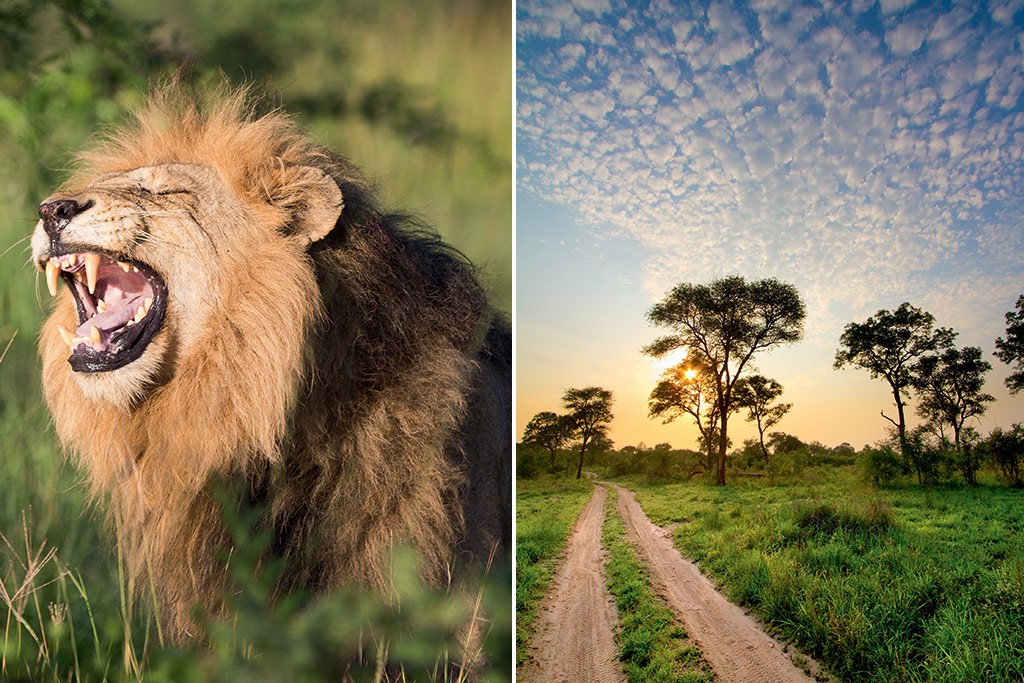
Manyeleti Game Reserve is particularly beautiful in November and December when the short grassy plains are lush, attracting a multitude of animals.
The Sabi Sands and Timbavati private game reserves might be world-renowned for their pristine bushveld and leopards up every second marula tree, but just one drive through Manyeleti was all it took to nudge them from the top of my list of favourite Lowveld reserves.
Tucked between these two exclusive reserves on the edge of Kruger, Manyeleti’s landscape is more scenic and open, which not only allows great visibility for sightings, but also attracts more plains game such as zebra, blue wildebeest and cheetah. On top of that, day visitors can explore the reserve’s main routes on their own. It’s not privately owned nor is it completely beyond the budget of the average South African. So it may seem strange that its half-built entrance gate is in a state of suspended animation and that the reserve itself is largely unheard of.
Nowhere else in the Lowveld can you watch lions from your car in some of the region’s most scenic and productive veld without having to share the sighting with other people. It’s just you, your camera and the Big Five.
The reason for the reserve’s relative obscurity lies in its beginnings. In the late 1800s, the local tribespeople in the Manyeleti area were removed and the land was assigned to white farmers, who remained until the late 1950s when it was purchased by the South African Development Trust for African settlement. Manyeleti Game Reserve was officially opened in 1967 by the Department of Bantu Development and Administration. It was managed as the only game reserve in South Africa where non-whites were allowed, and because of this the majority of wildlife-loving South Africans who could afford safari holidays skirted Manyeleti and headed straight for Kruger. For decades, it remained largely untouched until it faded into obscurity, a pocket of untapped potential in the rapidly developing world of ecotourism.
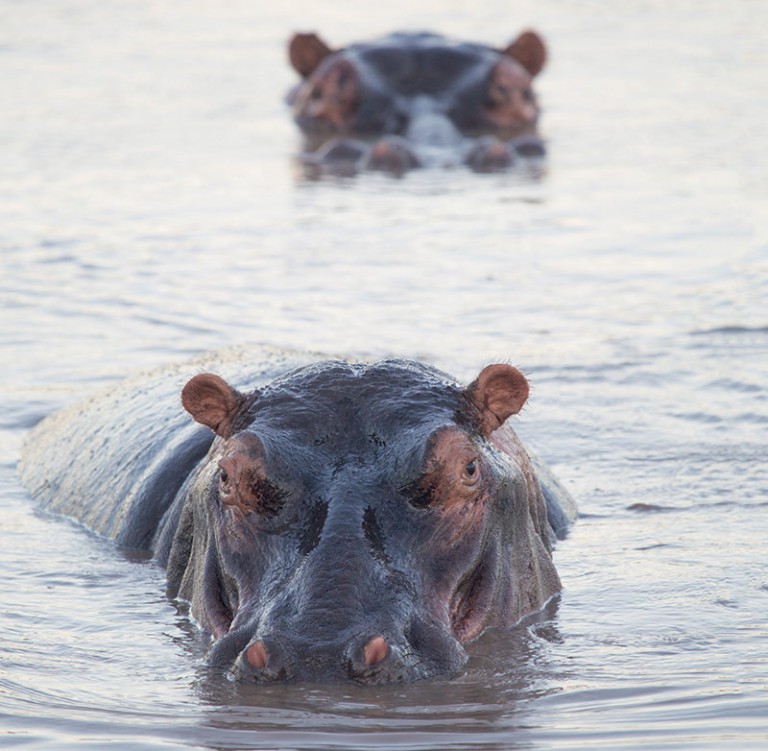
Stop at Main Dam to see hippos.
In 1980 Manyeleti came under the control of the Gazankulu Homeland Government. Then in 1994, the reserve was incorporated into the provincial government of the Northern Province, which later became Limpopo Province. By 2005, its management had been transferred to Mpumalanga provincial government. Land claims started in 1994, and though it’s still officially run by Mpumalanga Tourism and Parks Agency today, some of the claims seem to be going through, which means management of the park may be shifted to the community in the near future. Needless to say, until there’s some agreement on who is ultimately going to be responsible and all the paperwork involved in these transactions is signed, stamped, lost, found, and eventually approved by the right people, Manyeleti’s ‘new’ entrance will remain incomplete.
Fortunately, these constant changes in management have had very little impact on the wildlife and overall essence of the reserve, and at its heart Manyeleti Game Reserve itself has actually changed very little. Large leadwood trees grow along multiple drainage lines throughout the reserve, and though the reserve can’t boast either of the major rivers its neighbouring private reserves can, there is a large dam in the centre of Manyeleti and a multitude of natural pans. Resident elephants and rhinos often wallow in the muddy pans, as do huge herds of buffalo. For nearly an hour I watched well over a thousand of these sturdy beasts stroll down to a waterhole, covering the horizon in a long, dusty black line. Shadowing their movements more often than not are the lion, as well as a host of other predators that prey on the abundance of the region. Specials in the area include the side-striped jackal and serval, which are not regularly seen elsewhere, and cheetah, which love the open stretches in the northern half of the reserve.
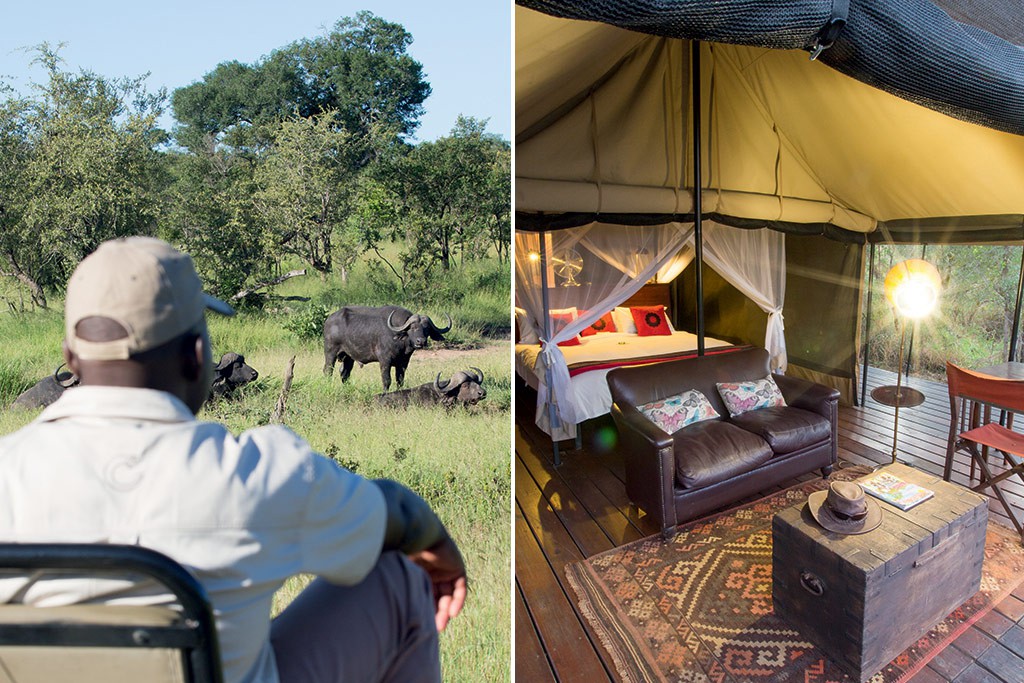
LEFT: Trackers not only spot animals, but also follow fresh tracks for the best chance to see the Big Five. RIGHT: Mantobeni’s tents feel extra spacious and give a spectacular view over the bushveld.
You’ll have to work hard for your sightings, though. Thanks to the low density of lodges, the game is more skittish than in higher density reserves such as Sabi Sands. But this is the sort of thing that good guides revel in. It enhances the wilderness and means that you rarely have to share sightings. With so few vehicles doing the rounds, there’s little to no waiting in line or jockeying for position at a sighting, and even when you’re not alone there isn’t a time limit on how long you can stay.
Although day visitors have the luxury of searching for the Big Five on their own, finding those lions and leopards, or even wild dogs, is a lot easier with one of the local guides, simply because they know every road, tree and waterhole, as well as the animals that frequent them. Their knowledge of the reserve and their experience at tracking and locating certain species or individual animals only enhances the Manyeleti experience.
In Shangaan Manyeleti means ‘the place of the stars’, and while it may not look like much on paper, or even from the gate, it’s impossible not to notice how it shines.
Status of the reserve
The gate: The northern entrance gate usually seems deserted until an officer appears to open the boom. If you arrive shortly after it opens, you’ll have to drive to the main camp to pay your entrance fees and to collect an exit permit. There are toilets, but they are often out of order or without toilet paper.
The roads: Day visitors are allowed to drive on the main gravel roads, which look similar to those in Kruger, but not the two-track lodge roads, which are marked with no-entry signs in places. They are in decent condition and good enough to drive on with a small sedan. You’ll be lucky to get a map at the entrance gate and even if you do, it’s still very easy to get lost without a guide because roads aren’t signposted. Tracks4Africa on your GPS could prove very valuable.
The management and ownership: Manyeleti is currently government owned, but has been under land claims for well over a decade. It’s managed by the Mpumalanga Tourism and Parks Agency, which is in charge of veld management, maintenance and anti-poaching. Even if the land claims do go through, the area will always be protected by the agency, or a similar institution, but with economic benefit to the community.
Make a day of it
Day visitors are allowed to drive in Manyeleti between 5:30 and 18:00 (October to February) and 6:00 and 17:30 (March to September). Day-visitor fees are R30 per person and R30 per vehicle. There are no functioning picnic sites in the reserve, but there are ablution facilities and a small shop that sells cold drinks and snacks at the park headquarters. Book a four-hour sunrise or sunset guided trip into Manyeleti through Timbavati Safari Lodge, located 20 minutes from Manyeleti’s northern entrance gate (on Orpen Road). R550 per person (minimum two), which includes entrance fees, snacks and sundowner drinks, but rates are about to increase.
How to get to Manyeleti
From Pretoria, drive on the N4 East for approximately 200km and then turn left towards Belfast. Follow the R540 over Dullstroom to Lydenburg and get onto the R36 North. Drive through Ohrigstad and over the Abel Erasmus Pass in the direction of Hoedspruit. Shortly after the R36 becomes the R527, turn right on the R531 that leads to Kruger National Park’s Orpen Gate. The entrance to Manyeleti Game Reserve is located on the R531, approximately seven kilometres before you reach Orpen Gate. The total distance and time is about 480 kilometres and roughly six and a half hours.
Best time to visit Manyeleti
Game viewing is always good in Manyeleti, but the veld varies greatly between the dry winter months (May to October) and the wet summer months (November to April). In winter the waterholes attract a steady flow of game and the dry, sparse vegetation increases visibility. In summer the veld is dense and lush, making it harder to spot animals, but from a photographic viewpoint it’s at its most scenic. The presence of numerous baby animals and migratory bird species such as the European roller, Diederick cuckoo and woodland kingfisher also make it worth visiting Manyeleti in summer.
Where to stay in Manyeleti
1. Ndzhaka and Buffelshoek
Ndzhaka and Buffelshoek are two community-run self-catering camps located in the centre and far south of the reserve, respectively. Both are rustic and unfenced, and each camp has five two-sleeper safari tents with en-suite ablution facilities and a communal kitchen. A resident herd of nyala often browse between the tents at Ndzhaka, which lies hidden in a dense patch of riverine forest on the banks of the N’waswitsontso riverbed. (Ed’s note: we’ve been informed that Ndzhaka Camp is currently not operational.)
Leopards are also frequently seen in the vicinity. Buffelshoek, which is in a more open area only a stone’s throw from the Sabi Sands boundary, is often visited by lions. Upgraded Buffelshoek Camp is R2000 per person per night including meals and one game drive per day; Ndzhaka Camp is R450 per person sharing, guided walks R300 per person and game drives from R150 per person.
Contact: Tel 0714444086, [email protected]
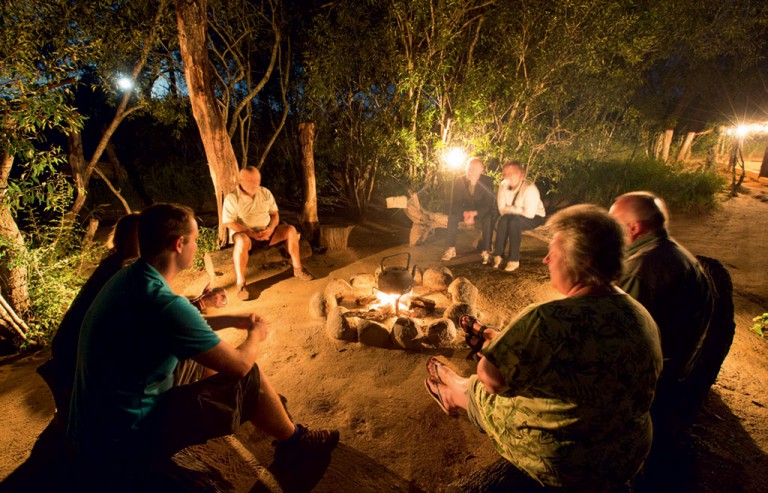
The place to be at Pungwe Bush Camp – sitting around the fire listening to barred owlets, spotted hyenas and perhaps even a roaring lion.
2. Pungwe Bush Camp
Pungwe Bush Camp is known and loved for its rustic, no-frills ambiance and maintains a feel of exclusivity with only four thatched units (a maximum of eight guests) at the southern tip of the reserve. The camp is entirely unfenced and electricity-free, and meals are often prepared over an open fire and enjoyed in the lantern-lit communal dining area or under the stars. Walking safaris are this camp’s speciality, though the occasional elephant ambling through camp means you don’t always need to go far for an incredible sighting. From R1595 per person per night sharing, including meals, a four-hour game drive and a four-hour walk.
Contact: Tel 0823575796, pungwe.co.za
3. Mantobeni and Khoka Moya
Mantobeni and Khoka Moya are Honeyguide’s two tented safari camps, which are as close to perfect as lodges can be. The camps are classy yet unpretentious, achieving that difficult-to-find balance between luxurious comfort and bushveld ambience without skimping on either. Combined with food to die for and guides who know their stuff and are good at sharing it, it’s the sort of place you’re bound to write home about. The only thing more wonderful than waking up in one of Mantobeni’s king-size beds in a Meru-style tent is listening to the echoing whoops of a spotted hyena in a nearby valley, as a fresh pot of tea is delivered to your tent before the morning drive (no children under 12). With a great big lawn and communal bonfire area surrounded by an open-plan bar, dining area and lounge, Khoka Moya does not resemble your typical safari lodge. It caters predominantly for large groups (up to 24) and families (children of all ages are welcome), accommodated in 12 safari tents that are slightly more contemporary than those at Mantobeni. Both Mantobeni and Khoka Moya are each from R3410 per person per night, including meals and activities.
Contact: honeyguidecamp.com
4. Tintswalo Safari Lodge
Tintswalo Safari Lodge is beautifully located on the seasonal N’waswitsontso riverbed in the north-west of the reserve. Although this super-luxurious lodge caters predominantly for overseas visitors, it’s the perfect place for local honeymooners to be pampered. Each room is fully laden with all the bells and whistles and 19th-century antique furnishings, as well as modern amenities of a five-star lodge. The reception area boasts an open-air dinner boma and a wine cellar, but most impressive is the enormous, centuries-old Jackalberry tree that dominates the main deck and casts an air of enchantment over the entire lodge. From R6980 per person per night, including a shoulder massage, all meals, drinks and game drives.
Contact: tintswalo.com
This article first appeared in the August 2015 issue of Getaway magazine.
All prices were correct at time of publication, but are subject to change at each establishment’s discretion. Please check with them before travelling.
